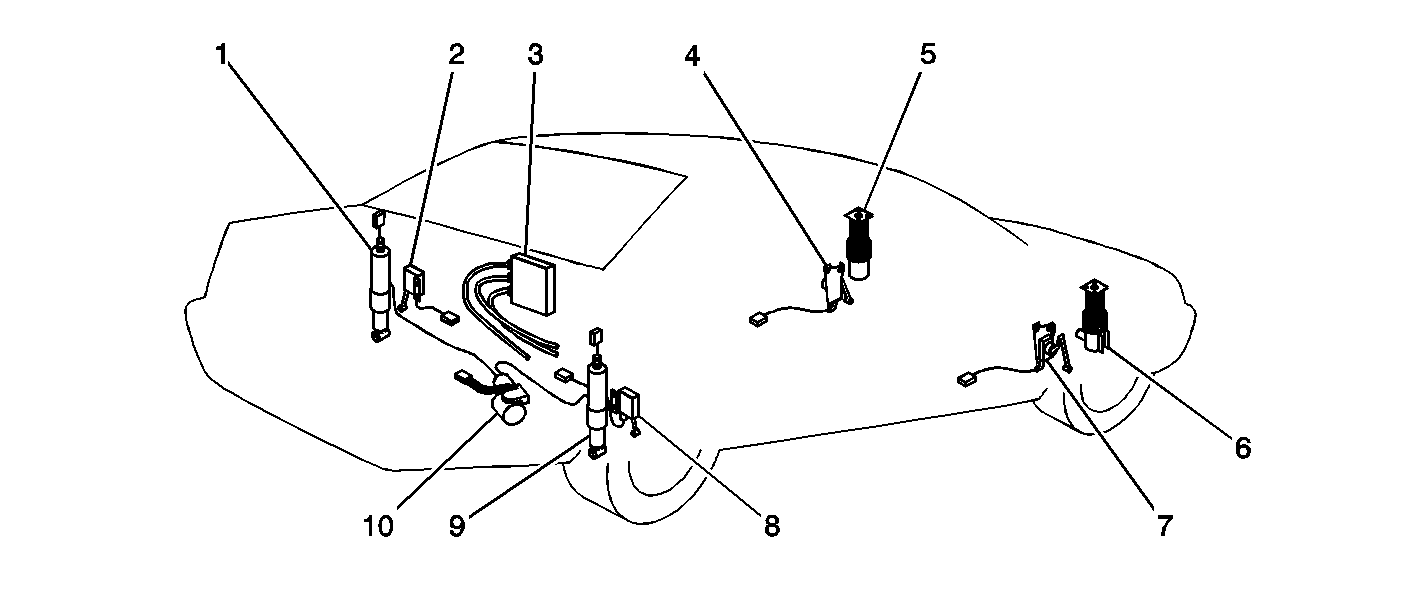
The Electronic Suspension Control (ESC) system consists of the following components:
| • | ESC module (3) |
| • | Four dampers contained in the 2 front struts (5 and 6) and the 2 rear shock absorbers (1 and 9) |
| • | Four positions sensors (2,4,7, and 8) |
| • | ALC air compressor module (10) |
| • | ELC relay (not shown) |
The ESC system with rear Automatic Level Control (ALC) controls damping forces in the front struts and rear shock absorbers in response to various road and driving conditions. The rear ALC portion of the system maintains a proper vehicle trim height under various vehicle load conditions. For more information on the ALC, refer to Automatic Level Control Description and Operation in Automatic Level Control.
The ESC module receives the following inputs: wheel-to-body position, vehicle speed, and lift/dive. The ESC module evaluates these inputs and controls actuators in each of the dampers independently to provide varied levels of suspension control.
Electronic Suspension Control (ESC) Module
The ESC module is used to control how firm or soft each shock or strut should be to provide the best ride. The ESC module is also used to control the vehicles rear height. The ESC module is located on the right side of the rear seat back and is accessed through the trunk.
Position Sensors
The position sensors are 0 to 5 volt DC output devices that are used to measure wheel-to-body movement/position. There are four position sensors on the vehicle, one per corner. Each position sensor is mounted between a suspension control arm and the body.
Shock Absorber or Strut
An ESC damper is mounted at each corner of the vehicle. The four suspension dampers, 2 front struts and 2 rear shock absorbers, each contain an integral actuator that is controlled by the ESC module. The actuator provides a wide range of damping forces between soft and firm levels. Damping is controlled by the amount of current supplied to the actuator via pulse width modulation.
The ESC rear shock absorbers and front struts are a monotube type which provide damping by increasing magnetic flux to magnetic particles to resist suspension movement. The ESC shock absorber or strut has the capability of providing multiple modes or values of damping forces, in both compression and rebound direction.
The damping forces are achieved by increasing or decreasing the magnetic flux to the shock absorbers or struts.
Vehicle Speed
The ESC module receives a vehicle speed input. It is obtained over the CLASS 2 serial communication buss. Vehicle speed is used to determine the amount of damper control necessary.
Lift/Dive
Lift/Dive input is received from the PCM. When the ESC module receives an active lift/dive input, it will command a firm damping level on all four corners. The lift signal is calculated in the PCM based on throttle position, transmission gear, vehicle speed, and brake switch status. The dive signal, also calculated in the PCM, is based upon the rate of change with the vehicle speed.
Warning Messages
The DIC displays two different warning messages that are set if there is an electronic suspension control system fault(s). The warning messages are as follows:
| • | SERVICE SUSPENSION SYS |
| • | SPEED LIMITED TO XXX |
The DIC will display one, both or none, depending on the fault that was encountered. The warning message(s) will continue to be displayed, until the fault(s) has been corrected.
